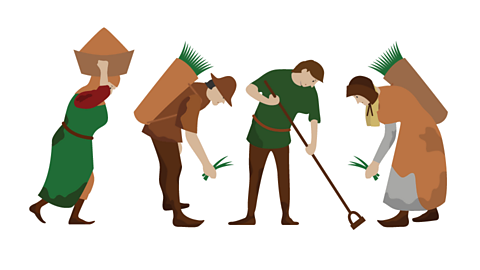Watch: The Normans in Ireland
Max Heartrate discusses what have the Normans ever done for us!
DIRECTOR: Standby on the floor.
DIRECTOR: Coming to you camera two.
DIRECTOR: Cue on two.
DIRECTOR: Mix-through.
MAX: No time for that! Hello! Iâm Max Heartrate and this is Knowledge Express. Information faster than a bee on a bullet. And todayâs topic isâŠ
MAX: The Normans â heard of them?
MAX: Not those Normans!
MAX: Big powerful lads from Northern France. Conquered England in 1066. King Harold shot in the eye with an arrow. Woof! Game over!
MAX: Meanwhile in Ireland a bloke called Dermot MacMurrough is pretty triggered by not being King anymore. So, he invites his Norman mate Richard de Clare a.k.a. Strongbow (cool name by the way!) to help him be king again.
MAX: Itâs 1169, Strongbow arrives, and his army give the Irish a beating in battle. All good for the Normans? No!
MAX: Because Henry II, King of England (hey nice âtache) is getting a bit twitchy because Strongbowâs becoming way too powerful, so he sends more Norman knights to sort it out.
MAX: Battles, castles, more battles, more castles, soon Henryâs in control of the place. Mind you, no-one conquers Ulster until John de Courcy marches up north and builds even MORE castles including Carrickfergus and Dundrum (how much did those guys love castles?).
MAX: But, he winds Henry up by putting his own head on a coin (huh, what a loser) and Hugh de Lacy arrives to send him packing. But hey, thatâs the Normans for you â live by the sword, die by the sword.
MAX: Next thing you know there are castles, cathedrals and monasteries all over the place, everyoneâs speaking English, thereâs a new legal system, and the place is divided into counties with fields and hedges to help farmers grow crops and pay rent to guess who?
*MAX:: The Normans!
MAX: There you go - The Normans in Ireland! Extremely violent but really well organised and here to stay! Or as we might say âAts us now!â
The Normans in Ulster
Castles are one of the most visible physical remnants of Norman Ireland.
As the Normans pushed further into Ireland they were not always welcomed by the locals or the Irish Kings whose land they were claiming. Therefore, castles were built first and foremost as a means of defence and a place where soldiers could be stationed safely.
Initially the Normans built Motte and Bailey castles.
The Motte was a mound of Earth with a dwelling to live in and the Bailey a flat area for soldiers and horses.
Both were surrounded by a high fence called a stockade. The mounds from a Motte and Bailey can still be seen at Downpatrick and Dundrum.

From the 13th century onwards the Normans began to use castles built with stone that resemble our idea of what a castle looks like.
These had the advantage of being more difficult to attack and could cope far better with the wintry weather of the British Isles.
The best preserved early Norman castle in Northern Ireland is Carrickfergus Castle. This was the seat of the Norman, John de Courcy.
It is a very good example of the defensive nature of castles as it is perched on a hill to make it more difficult for enemies to attack it on foot or with heavy weapons.
It is also located at the harbour, meaning over half of the perimeter is surrounded by water which acts as a natural defence. The outer walls are several metres thick and there are also inner walls for any invader to deal with.
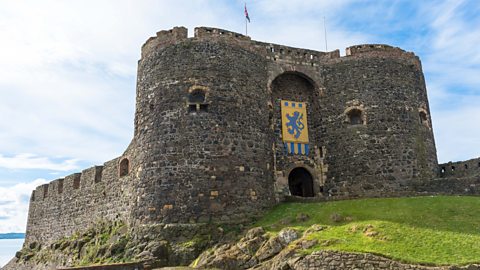
The castles also served as a hub of Norman life.
The Keep, a tower-like structure, is where the Lord would live. He occupied the top floor of the keep, a symbol of his position and the best furnished room in the castle.
The Keep would also be the venue for the great banquets that the Normans held to celebrate important occasions and religious feast days. These banquets would be prepared in the kitchens in the lower floors.
At the banquet, the Lord would sit at the top table and get the best cuts of meat. Your position at the table and the quality of the meat that you received depended on your position among the local Normans.
Changes in the way of life
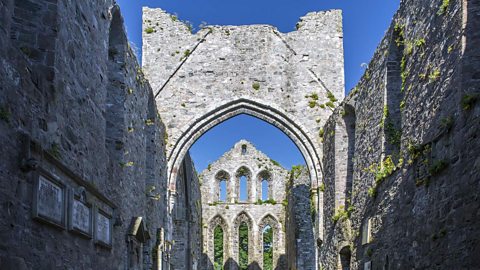
There were lots of elements of life in Ireland that would change because of the Normans. The native way of life was not replaced, but Norman ways and customs became part of Irish life.
- The Normans established many new towns such as Athlone, Drogheda and Carrickfergus. The towns tended to be similarly designed with a set of walls, protective gates and a market square for traders. They were usually built near a river and would have either a river or a monastery associated with them. Most people lived in timber houses in the narrow lanes within the gates. Only wealthy merchants could afford houses made of stone
- There were changes in farming. The Normans grew a much wider range of crops and they introduced innovations such as crop rotation whereby one field was left to recover every year.
- The Norman system of law came into use. By the end of the 15th Century all Irish laws had to be approved by the King of England. As English was the language of the legal system, it took on an official status and it began to be used as a native language.
- There were big changes for the Church. The Pope had wanted the Irish to follow the Church's rules more closely and the Normans ensured this would happen. They built stone churches and established a parish system. These parishes would be grouped together to form a diocese, which would then be headed by a bishop. This allowed for a great degree of control by the Church leadership.
- Irish surnames such as Burke, Costello, Fitzgerald, Fitzsimons and Butler are just some that have Norman roots.

What were the Statutes of Kilkenny?
As the Normans settled in Ireland they began to adopt many of the local customs, they married into Irish families and even began to speak the Irish language. This became so noticeable that in 1366 King Edward III of England introduced a new set of rules called the Statutes of Kilkenny.
As a result of these regulations Normans were not allowed to:
- marry Irish natives
- speak the Irish language
- dress in the manner of the Irish
In spite of this, many Normans continued to integrate with the Irish.
Beyond the Pale
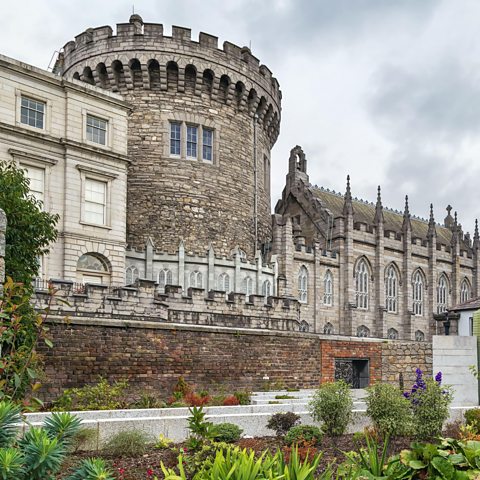
As time went on, English Kings became more concerned with protecting their valuable lands in France and there was a loosening of control.
Some Irish Kings even regained land and by 1500 there was only one part of Ireland surrounding Dublin, called the Pale, where the Normans held complete control and the English way of life dominated.
The Normans ruled Ireland from Dublin but could not fully control it beyond this territory. You may have heard of the phrase beyond the pale to describe uncivilised behaviour. It comes from the description that the Dublin Normans used for the Irish outside of this territory.
The coming of the Normans established a connection between Ireland and England. From the time that King Henry II came it was considered to be part of the lands of the English crown.
Ireland would become more modern and wealthier, but the role of the English crown would cause many disputes in the centuries to come.

Quiz: How much do you know?
More on The Normans
Find out more by working through a topic
- count1 of 6

- count2 of 6
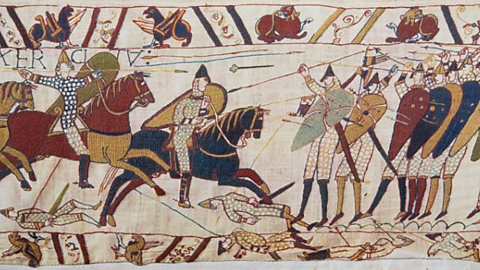
- count3 of 6
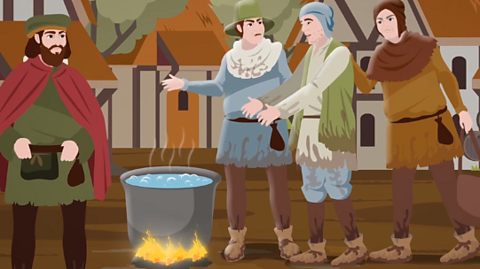
- count4 of 6
